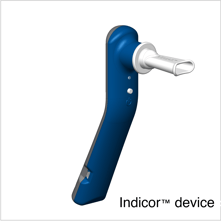 Last month at Vixiar Medical, we reached a major milestone on the road to commercial launch of our Indicor™ device with the submission of our 510(k) to the FDA. We hope to have clearance to market our product in the fall, after which we will begin our first phase of commercial activity. Getting a medical device to market can be a long road. Studies reveal an industry average of three to seven years to get a device in the hands of customers.
Last month at Vixiar Medical, we reached a major milestone on the road to commercial launch of our Indicor™ device with the submission of our 510(k) to the FDA. We hope to have clearance to market our product in the fall, after which we will begin our first phase of commercial activity. Getting a medical device to market can be a long road. Studies reveal an industry average of three to seven years to get a device in the hands of customers.
In addition to all the requisite steps for any product development process (ideation, prototyping, engineering development, testing, etc.), medical devices also typically go through two other gates that non-medical products don’t experience—clinical trials and regulatory approval. Though time consuming, both are necessary in assuring a new medical technology is safe and effective. Low to moderate risk devices go through the 510(k) pathway to get regulatory approval in the US. The FDA 510(k) process requires a manufacturer to demonstrate that its product is safe and effective and that it is “substantially equivalent” to an already cleared “predicate device.” This requires the manufacturer to do extensive testing both internally and through external labs. Examples of required testing that we conducted included electrical safety, biocompatibility of materials, device functional performance, cleaning and disinfection and cybersecurity. Reports on this testing are included in the 510(k) submission along with a detailed description of the device and the manufacturer’s own assessment of any risks associated with the device and how such risks are mitigated. That’s all wrapped up in an electronic file and sent to the FDA for review. Our package was filed on June 22nd and was over 2,000 pages! The FDA has 90 days to review and respond but has the option to ask questions or request additional information, which puts the submission clock on hold until the manufacturer provides responses that are satisfactory to the agency. The average 510(k) decision takes almost 6 months. We are hoping our clearance is closer to three months. We will know by the end of August if the FDA has questions and are prepared to respond quickly if they do. As soon as the FDA issues a “substantial equivalence letter,” Vixiar can begin legally marketing the Indicor to clinicians and start doing the good work of helping patients.
Heart Failure: a major burden on patients, providers and payers
 Vixiar’s first product, the Indicor, is focused on patients with heart failure. Heart failure, often referred to as congestive heart failure, occurs when the heart can’t pump or fill with blood as well as it should and therefore the body is deprived of oxygen and nutrients. Conditions such as coronary artery disease, high blood pressure or diabetes gradually lead to a heart that is too weak or stiff to pump efficiently. The reason it is referred to as congestive heart failure is that because the heart can’t pump or fill as well as it should, fluid (i.e., congestion) backs up to the lungs and other parts of the body which causes the major symptoms of heart failure including shortness of breath, fatigue, rapid heart rate and swelling of the legs, feet and abdomen. Chronic heart failure patients are prone to frequent exacerbations of their disease which all too often leads to a trip to the emergency room and hospitalization. The numbers are staggering: There are 6 million heart failure patients in the US and 26 million globally. In the US, there are 1.2 million hospitalizations annually and readmissions are a major problem. Twenty-five percent of patients get readmitted within 30 days and 50% within six months. For patients, this frequent flyer status brings increased mortality and morbidity. For provider hospitals it means unreimbursed costs and penalties applied through the CMS Readmissions Reduction Program. And finally, for insurers it means spiraling costs currently totaling over $30 billion in total direct costs.
Vixiar’s first product, the Indicor, is focused on patients with heart failure. Heart failure, often referred to as congestive heart failure, occurs when the heart can’t pump or fill with blood as well as it should and therefore the body is deprived of oxygen and nutrients. Conditions such as coronary artery disease, high blood pressure or diabetes gradually lead to a heart that is too weak or stiff to pump efficiently. The reason it is referred to as congestive heart failure is that because the heart can’t pump or fill as well as it should, fluid (i.e., congestion) backs up to the lungs and other parts of the body which causes the major symptoms of heart failure including shortness of breath, fatigue, rapid heart rate and swelling of the legs, feet and abdomen. Chronic heart failure patients are prone to frequent exacerbations of their disease which all too often leads to a trip to the emergency room and hospitalization. The numbers are staggering: There are 6 million heart failure patients in the US and 26 million globally. In the US, there are 1.2 million hospitalizations annually and readmissions are a major problem. Twenty-five percent of patients get readmitted within 30 days and 50% within six months. For patients, this frequent flyer status brings increased mortality and morbidity. For provider hospitals it means unreimbursed costs and penalties applied through the CMS Readmissions Reduction Program. And finally, for insurers it means spiraling costs currently totaling over $30 billion in total direct costs.
The problem with heart failure patients is that by the time they develop physical signs and symptoms, a trip to the emergency room is usually unavoidable. But before these signs and symptoms occur, fluid volume and pressure changes are present in patients referred to as hemodynamic congestion. This precursor to clinical congestion is difficult to detect. Studies suggest that over 40% of patients leave the hospital with undetected hemodynamic congestion which makes these patients high risk for readmission. This is where the Vixiar Indicor comes in.
Technology standardizes a trusted maneuver
 We have developed a handheld device and software platform that detects changes in fluid volume in the chest that lead to hemodynamic congestion. The Indicor standardizes the Valsalva Maneuver, an exhalation against a closed airway similar to blowing up a balloon or straining for a bowel movement. Here is how it works: the patient blows into the device for ten seconds while watching a virtual pressure gauge. The strain of the Valsalva cuts off blood returning to the heart. Cardiac output is then reduced and then, downstream, peripheral pulse. A sensor placed on the patient’s finger captures his pulse response before, during and after the strain. In a healthy individual, the Valsalva impedes blood flow and the pulse signal displays a steep decrement in amplitude representing the limited blood flow during the strain. However, in the heart failure patient, there is little to no decrement in pulse pressure because excess fluid in the lungs (congestion) serves as a reservoir that feeds the heart with blood and downstream, pulse remains virtually unchanged. The Indicor’s algorithm analyzes the pulse response and outputs and index of hemodynamic congestion, the Valsalva Pulse Response. The test is fast, non-invasive and easy to perform.
We have developed a handheld device and software platform that detects changes in fluid volume in the chest that lead to hemodynamic congestion. The Indicor standardizes the Valsalva Maneuver, an exhalation against a closed airway similar to blowing up a balloon or straining for a bowel movement. Here is how it works: the patient blows into the device for ten seconds while watching a virtual pressure gauge. The strain of the Valsalva cuts off blood returning to the heart. Cardiac output is then reduced and then, downstream, peripheral pulse. A sensor placed on the patient’s finger captures his pulse response before, during and after the strain. In a healthy individual, the Valsalva impedes blood flow and the pulse signal displays a steep decrement in amplitude representing the limited blood flow during the strain. However, in the heart failure patient, there is little to no decrement in pulse pressure because excess fluid in the lungs (congestion) serves as a reservoir that feeds the heart with blood and downstream, pulse remains virtually unchanged. The Indicor’s algorithm analyzes the pulse response and outputs and index of hemodynamic congestion, the Valsalva Pulse Response. The test is fast, non-invasive and easy to perform.
A market across the continuum of care
Post FDA clearance, our team will move into the commercial phase and begin marketing the device. The Indicor is designed to be used at the point of care in hospitals, skilled nursing facilities, doctors' offices and patients' homes. We will start our sales process in hospitals where heart failure experts reside and where clinicians need a tool to detect fluid changes and ideally to avoid discharging patients with hemodynamic congestion. Moving into the homecare market, the Indicor will provide clinicians with a remote monitoring tool and allow clinicians to watch for increases in congestion and intervene earlier to ideally avoid hospitalizations. In our post COVID19 world, this will help patients and clinicians avoid unnecessary exposure.
To learn more visit vixiar.com

